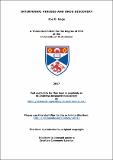Files in this item
Interferon, viruses and drug discovery
Item metadata
| dc.contributor.advisor | Adamson, Catherine S. | |
| dc.contributor.advisor | Randall, R. E. | |
| dc.contributor.author | Gage, Zoe O. | |
| dc.coverage.spatial | xx, 200 p. | en_US |
| dc.date.accessioned | 2017-01-19T12:59:46Z | |
| dc.date.available | 2017-01-19T12:59:46Z | |
| dc.date.issued | 2017-06-21 | |
| dc.identifier | uk.bl.ethos.701527 | |
| dc.identifier.uri | https://hdl.handle.net/10023/10127 | |
| dc.description.abstract | The interferon (IFN) response is a crucial component of cellular innate immunity, vital for controlling virus infections. Dysregulation of the IFN response however can lead to serious medical conditions including autoimmune disorders. Modulators of IFN induction and signalling could be used to treat these diseases and as tools to further understand the IFN response and viral infections. We have developed cell-based assays to identify modulators of IFN induction and signalling, based on A549 cell lines where a GFP gene is under the control of the IFN-β promoter (A549/pr(IFN-β).GFP) and the ISRE containing MxA promoter (A549/pr(ISRE).GFP) respectively. The assays were optimized, miniaturized and validated as suitable for HTS by achieving Z’ Factor scores >0.6. A diversity screen of 15,667 compounds using the IFN induction reporter assay identified 2 hit compounds (StA-IFN-1 and StA-IFN-4) that were validated as specifically inhibiting IFNβ induction. Characterisation of these molecules demonstrated that StA-IFN-4 potently acts at, or upstream, of IRF3 phosphorylation. We successfully expanded this HTS platform to target viral interferon antagonists acting upon IFN-signalling. An additional assay was developed where the A549/pr(ISRE).GFP.RBV-P reporter cell line constitutively expresses the Rabies virus phosphoprotein. A compound inhibiting viral protein function will restore GFP expression. The assay was successfully optimized for HTS and used in an in-house screen. We further expanded this assay by placing the expression of RBV-P under the control of an inducible promoter. This demonstrates a convenient approach for assay development and potentiates the targeting of a variety of viral IFN antagonists for the identification of compounds with the potential to develop a novel class of antiviral drugs. | en_US |
| dc.language.iso | en | en_US |
| dc.publisher | University of St Andrews | |
| dc.rights | Attribution-NonCommercial-NoDerivatives 4.0 International | * |
| dc.rights.uri | http://creativecommons.org/licenses/by-nc-nd/4.0/ | * |
| dc.subject | Interferon | en_US |
| dc.subject | HTS | en_US |
| dc.subject | Drug discovery | en_US |
| dc.subject | Screening | en_US |
| dc.subject | IFN | en_US |
| dc.subject | Innate immunity | en_US |
| dc.subject | IRF3 | en_US |
| dc.subject | High-throughput | en_US |
| dc.subject.lcc | QR187.5G2 | |
| dc.subject.lcsh | Interferon | en |
| dc.subject.lcsh | Biological response modifiers | en |
| dc.subject.lcsh | High throughput screening (Drug development) | en |
| dc.subject.lcsh | Drug development | en |
| dc.title | Interferon, viruses and drug discovery | en_US |
| dc.type | Thesis | en_US |
| dc.contributor.sponsor | SULSA-MSD | en_US |
| dc.contributor.sponsor | Merck Sharp & Dohme. Scottish Life Sciences Fund | en_US |
| dc.type.qualificationlevel | Doctoral | en_US |
| dc.type.qualificationname | PhD Doctor of Philosophy | en_US |
| dc.publisher.institution | The University of St Andrews | en_US |
The following licence files are associated with this item:
This item appears in the following Collection(s)
Except where otherwise noted within the work, this item's licence for re-use is described as Attribution-NonCommercial-NoDerivatives 4.0 International
Items in the St Andrews Research Repository are protected by copyright, with all rights reserved, unless otherwise indicated.


